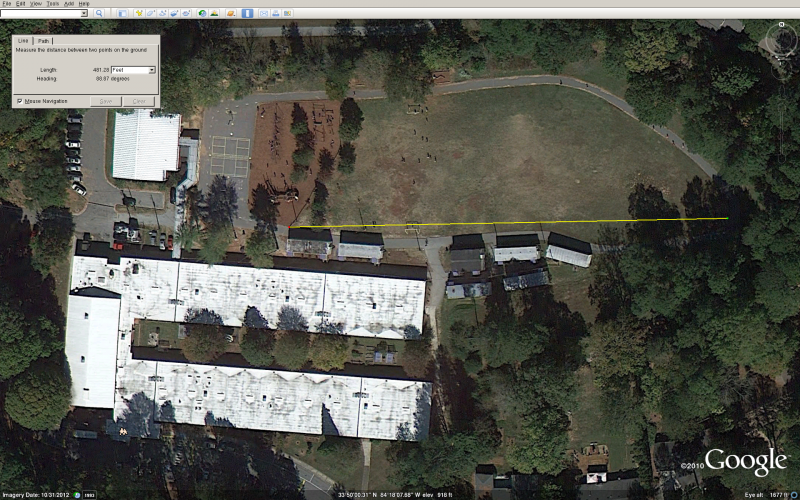Solar System scale activity: Difference between revisions
(→Activity: Explain) |
(Add orbit radius difference from prior planet) |
||
| Line 7: | Line 7: | ||
{| class="wikitable" |
{| class="wikitable" |
||
|+ Solar System at <br>1/1,264,000,000 Scale |
|+ Solar System at <br>1/1,264,000,000 Scale |
||
! What !! Diameter !! Orbit Radius (feet) |
! What !! Diameter !! Orbit Radius (feet) !! Difference from Prior (feet) |
||
|- |
|- |
||
| Sun || Grapefruit (4.3″) |
| Sun || Grapefruit (4.3″) |
||
| Line 13: | Line 13: | ||
| Mercury || 4 hair widths (0.0151″) || 15 |
| Mercury || 4 hair widths (0.0151″) || 15 |
||
|- |
|- |
||
| Venus || 10 sheets of paper thick (0.0376″) || 28 |
| Venus || 10 sheets of paper thick (0.0376″) || 28 || 13 |
||
|- |
|- |
||
| Earth || 1 millimeter (0.0396″) || 39 |
| Earth || 1 millimeter (0.0396″) || 39 || 11 |
||
|- |
|- |
||
| Mars || ½ the size of Earth (½mm) (0.021″) || 59 |
| Mars || ½ the size of Earth (½mm) (0.021″) || 59 || 20 |
||
|- |
|- |
||
| Jupiter || Almost half-inch (0.4448″) || 202 |
| Jupiter || Almost half-inch (0.4448″) || 202 || 143 |
||
|- |
|- |
||
| Saturn || Hieght of Lego brick (0.3622″) || 370 |
| Saturn || Hieght of Lego brick (0.3622″) || 370 || 168 |
||
|- |
|- |
||
| Uranus || 0.146″ || 744 |
| Uranus || 0.146″ || 744 || 374 |
||
|- |
|- |
||
| Neptune || 0.1413″ || 1,167 |
| Neptune || 0.1413″ || 1,167 || 423 |
||
|- |
|- |
||
| Voyager spacecraft <br>(farthest man-made object) || || 4,590 (0.87 miles) |
| Voyager spacecraft <br>(farthest man-made object) || || 4,590 (0.87 miles) |
||
Revision as of 13:55, 27 April 2014
In 2014-04, I was asked by Sagamore second grade teacher Ms. Quinn to help do something for the first grade and kindergarteners on Sagamore Space Day. I'd like to do what I proposed back in January, of imagining the real scale of the solor system, riffing off of, "How Big is the Solar System? | It's Okay to be Smart | PBS Digital Studios - YouTube".

I'm using an online solar system scale calculator to see what our solar system model can look like. Although the video serves science education by using metric units, I wonder if we should use US customary units instead? Using the scale chosen in the video, 1,264,000,000:1 (calculated from the video's stated 110 cm (4.3 inch) grapefruit = 1.39 million kilometer sun)!, we can comfortably get out to Saturn at 370′. A 5.5′ sun gets us Saturn at 470′ (the length of our field) and a scale of 1,600,200,000:1 , but I think I'll stick with their scale because they give us good size references (e.g. Mercury is only the width of just 4 human hairs).
| What | Diameter | Orbit Radius (feet) | Difference from Prior (feet) |
|---|---|---|---|
| Sun | Grapefruit (4.3″) | ||
| Mercury | 4 hair widths (0.0151″) | 15 | |
| Venus | 10 sheets of paper thick (0.0376″) | 28 | 13 |
| Earth | 1 millimeter (0.0396″) | 39 | 11 |
| Mars | ½ the size of Earth (½mm) (0.021″) | 59 | 20 |
| Jupiter | Almost half-inch (0.4448″) | 202 | 143 |
| Saturn | Hieght of Lego brick (0.3622″) | 370 | 168 |
| Uranus | 0.146″ | 744 | 374 |
| Neptune | 0.1413″ | 1,167 | 423 |
| Voyager spacecraft (farthest man-made object) |
4,590 (0.87 miles) | ||
| Betelgeuse (Red giant star) |
135′ | ||
| Sirius B (White dwarf star) |
0.0433″ |
| What | Distance from Sun (miles) |
|---|---|
| Alpha Centauri (Nearest star) |
2,000 |
| Galactic center (Center of Milky Way) |
12,873,222 |
| What | Quantity |
|---|---|
| Light Speed | 1 inch per second |
| Light Year | 465 miles |
Activity
I imagine taking kids out to the field, starting in the eastern corner, and explaining the concept of scale. Out comes the (grapefruit?) Sun and a bags of little objects. Invite them to choose the right size objects and place them around the Sun, at the same kind of distance the planets really are from the Sun (to scale).
Establish a foot by measuring the leaders foot and deciding how they'll walk to measure out feet.
The leader will have their own bag of planets to scale, taped to flags to be planted.
Then the distance is correct distance is shared, and the group counts out he paces. The true model planet is revealed, a factoid is shared; imaginations are challenged. Repeat up to Saturn (when room is run out).
I know it might be hard to keep all kids engaged. But, it's outside, they get to run around a bit and count out paces, and I think seeing how tiny the planets actually are and how far away everything is, can impart a real impression of the reality of space.